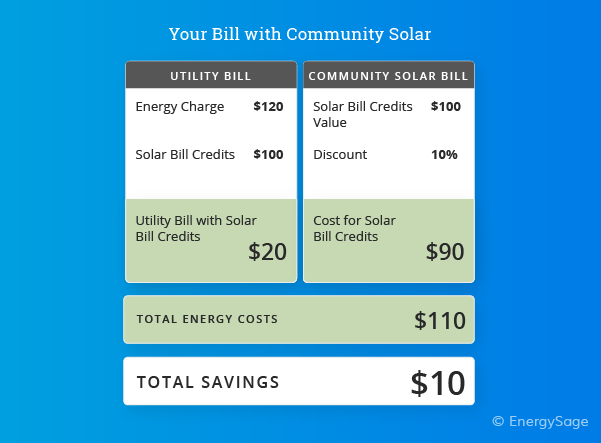Guest post by Casey McDevitt of EnergySage
Solar power is a long-lasting and cost-cutting renewable energy solution, but installing a home solar panel system isn’t feasible for everyone. Luckily, the benefits of solar aren’t limited to those who have panels on their rooftops. Community solar allows anyone unable to install solar panels on their property to receive the financial and societal benefits of solar without the installation or upfront costs.
According to a recent report released by Wood Mackenzie in collaboration with the Coalition for Community Solar Access, the community solar market should grow 118% over the next 5 years, with at least 6 gigawatts of additional community solar capacity expected to come online between 2023 and 2027. CCSA’s new target of 30 gigawatts by 2030 will require establishing new state markets. They’re not available everywhere, but it’s easy to join a local solar farm.
What is community solar?
Community solar is a way to access clean and affordable energy without having to install solar panels on your own property. A large-scale solar array, called a solar farm or solar garden, is privately developed somewhere within your utility service area. This solar farm produces and feeds renewable energy to the grid, lessening your community’s reliance on fossil fuel power plants and contributing to a cleaner local environment. As a utility customer, you’re eligible to subscribe to this solar project and receive a discount on your electric bills. Every program is unique, but on average, community solar subscribers save about 5–15% on electric bills annually—without having to purchase, install, or maintain a home solar panel system.
Beyond eliminating capital expenditures, community solar has many advantages, especially for renters or those who live in a home that’s unsuited to supporting its own array of solar panels. Homeowners with shaded roofs or historic buildings were previously excluded from this marketplace.
Some of the links in this article are affiliate links, meaning at no additional cost to you, we will earn a commission if you click through and make a purchase. Thank you for helping us continue to bring you great content.

1. Community solar can save you money
With utility electricity rates increasing every year, community solar lets homeowners and renters save money on electricity, without adjusting their consumption or investing in new energy-efficient systems.
It usually works like this: every month, you’ll receive a bill directly from your community solar provider in addition to your normal utility bill. You receive a 10% discount on the energy that your share of the community solar farm produces and feeds into the grid, which you will see on your utility bill as a credit. For example, if your utility energy charge is $120 and your solar share produces $100 worth of electricity that month, you’ll receive a $100 credit on your utility bill, bringing the total on your utility bill to just $20. While you’ve received the full $100 credit on your utility bill, you’re only paying your community solar provider $90 for that energy.
2. Community solar can benefit the environment
Every unit of solar energy produced is one less unit of fossil fuel–generated energy used to power the grid. By choosing community solar, you’re supporting the development of renewable energy sources, with zero operational emissions of CO2, and contributing to a cleaner environment. Just like rooftop solar, community solar farms improve local air quality. Many pollutants from burning fossil fuels are proven to impact health, but particulate matter and ozone are considered regional air pollutants and are sensitive to weather conditions. Community solar is also typically more efficient, due to solar farms’ optimized locations and solar conditions.
3. Community solar is accessible
Between the easy enrollment process, lack of installation and homeownership requirements, and little to no upfront costs, community solar expands the benefits of solar energy to those traditionally locked out of the market. In addition to renters and those who lack a solar-suitable roof, community solar is an accessible avenue for low-to-moderate–income (LMI) communities with high electricity burdens (i.e., percentage of household income spent on electricity costs); allowing them to participate in the cost savings of solar energy while improving their local environment. Increasingly, states are implementing LMI-specific solar policies to ensure that LMI communities are included in solar programs.
Community solar is regulated at the state level and availability varies accordingly. Historically, the majority of community solar production was limited to a few key states, but markets are expanding rapidly across the country. Currently, 41 states and Washington, DC, have at least one active community solar project.
“Westmill Solar Cooperative 1” image by MrRenewables Westmill Solar Co-operative licensed by CC BY-SA 3.0 DEED.

4. Community solar is local
Unlike some other electricity alternatives, community solar is always local. Community solar projects are developed within the cooperating utility’s service area and typically in areas with plenty of open space, like along highways or on warehouses and landfills. That means that 100% of the renewable energy produced on-site goes to the local grid. Additionally, community solar projects create jobs, contribute to local and state taxes, and boost the local economy.
5. Signing up for community solar is easy and free
Community solar offers flexibility when it comes to choosing a project that fits your energy and budgetary needs, and signing up can be easy and free. Some programs have upfront costs or fixed monthly payments, as opposed to a low-barrier subscription with no long-term commitment. But the EnergySage Community Solar Marketplace connects solar shoppers with reputable community solar projects across the United States. It’s easy to compare estimated savings, project details, and subscription options to find your best fit.
The author:
Casey McDevitt is an EnergySage writer covering solar, community solar, and sustainability. She is passionate about making clean energy more accessible to everyone and has worked in clean energy communications since graduating from the University of New Hampshire with a bachelor’s in Business Administration.









